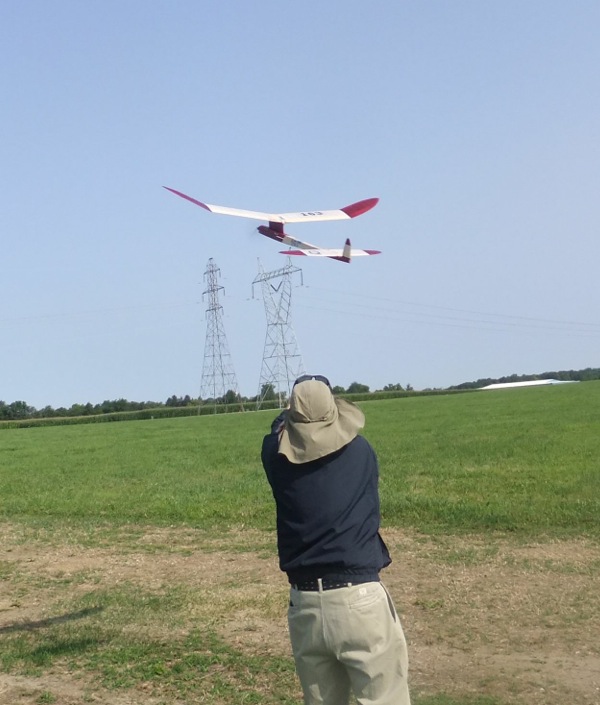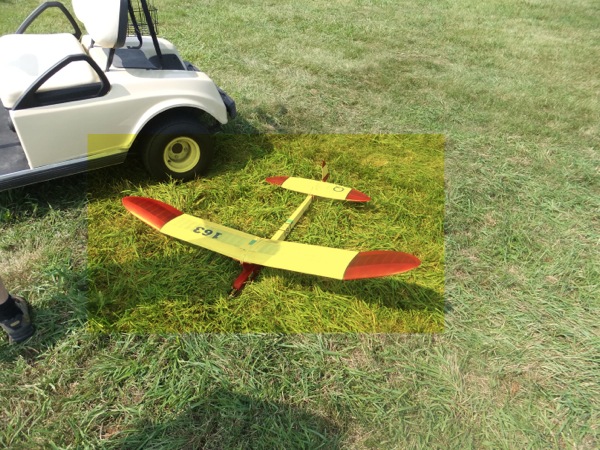
This week I am reliving something I did a lot of, 40-50 years ago. I am spending time at a competition attended by several hundred folks from all over the country. These folks, and their families, are spending their days in an 1100 acre field owned by the Academy of Model Aeronautics, and used for model airplane competitions of all kinds. This week, it is an event called the "Free Flight Nationals", where the models use a variety of means to get up into the sky, then glide back to earth. Simple, huh?
Well, not so simple. The real challenge for all of the events held this week is finding a thermal, a column of rising air, and riding that thermal for as long as possible. Ideally, the model stays aloft for three minutes, then the model activates a "de-thermalizer", a mechanism that causes the model to stop riding the thermal and descend to earth using the wing as a parachute. If you get to three minutes, you are said to have "maxed". Each competitor flies the same model over and over for a total of six flights, or more if they "max out" on all six. The competitor with the highest total time at the end of the flying wins the event.
Different events have different rules. Some rules dictate how the model gets up in the sky. There are hand launched events where you throw the model skyward like a javelin, or even a discus. There are powered events where a propeller is spun by a gas or electric motor, or even a wound-up rubber band! In the engine powered events, the time the engine is allowed to run is limited and timers are used to control that. Once the power is off, the model goes into the gliding mode and hopefully finds one of those thermals to take it higher and keep it aloft longer.
There is am amazing amount of science and technology in these models, and I got into this as a teenager trying to understand how airplanes worked. I learned a lot doing this! Unfortunately, there is no game controller in any of this, so it is hard to get kids interested in any of this today. That is their loss, I am afraid.
Chasing the models
The hard part of all of this is chasing the models down after the flight ends. In three minutes, if the wind is blowing, a model can be a long way downwind. Most of the competitors use either a motorcycle or a golf cart to chase their model down.
Those work great when the model lands in sight. The big problem comes when the model lands in a corn field, or even a bean field. Those durn plants open up and swallow a model airplane so well, they cannot be seen from the edge of the crop field, so finding the model becomes a form of search and rescue.
In fact, most models today carry a low power radio transmitter that emits a beacon tone every second or so. Radio direction finding equipment is used to try to locate the models.
I used to do a form of this activity as a Ham Radio Operator in New Mexico. We used highly directional antennas, called yagis, to listen on the transmitting frequency, then turned the antenna back and forth listening for the strongest signal and getting a bearing on the transmitter. In my HAM tracking days, we drew lines on plastic coated maps to show where we thought the transmitter was, then relocated to get another bearing. This is called triangulation, and could do a good job of pinpointing the signal. Unless the radio signal was bouncing off of something like a mountain. Unlike light waves, radio can bounce in surprising ways making exact locating tough to do. This was part of Ham Radio supporting search-and-rescue activities in the area. Aircraft carry beacons for just this purpose, and occasionally one will crash land in the mountains and we have to hunt for them. It can be difficult work, and you have to do it quickly.
So it can be with tracking the models as well. This afternoon, my friend, Jim Coffin, launched one of his airplanes, and we were sure it landed in a bean field on the edge of the flying field we were using. We headed off with the direction finding equipment and wandered along the edge of the bean field trying to get a fix on where the model was. Back and forth we went, trying to figure this out. Finally, we spun the antenna around listening to the radio and got a strong signal in the opposite direction. There was Jim's model sitting on the side of a pickup truck nearby. The owner of that truck saw the plane come down and retrieved it for us. He placed it in plain (plane?) sight and we finally found it.

Great fun!
Comments
There are no comments yet.